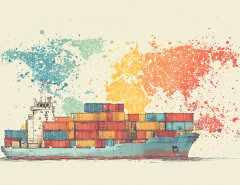Technology is often seen as something that is about industries, especially those dependent on innovation. The ‘FICCI-EY Report on Innovation and Critical Technologies,’ however, highlights the fact that the fruits of scientific progress are shared more widely than the common perception lets it. And that includes agriculture, which “has seen a surge of innovation from agritech startups in recent years. These companies leverage technology like AI, IoT, data analytics, and blockchain to address critical challenges…”
India’s Agricultural Transformation
India has achieved remarkable progress in agriculture, ensuring food security and emerging as a global leader in cereals, horticulture, dairy, and fisheries. The report highlights an important fact: “India’s horticulture sector is more productive and profitable than traditional agriculture, emerging as a fast-growing industry.” Grape cultivation in Nashik illustrates how export-oriented farming, technology adoption, and collective efforts can uplift rural livelihoods. Allied sectors—dairy, livestock, and fisheries—have also expanded rapidly, making India the world’s largest milk producer and a key player in aquaculture.
The report also underscores deep structural challenges, including heavy reliance on chemicals and irrigation (resulting in degradation of soil and lowering water tables). Then there are small and fragmented holdings which limit mechanisation, access to credit, and economies of scale. Inefficient supply chains and poor storage cause 10-15 per cent post-harvest losses, while MSP procurement benefits remain geographically concentrated. Climate change is another big threat, with government projections warning of up to 20 per cent yield declines in rice and wheat by 2050. Already, agriculture has lost 5.4 per cent of GDP to climate-related stress.
To address these challenges, India is turning to agritech and food processing innovations—precision farming, IoT-based irrigation, AI-driven pest prediction, drones, and blockchain-enabled supply chains. Startups are reshaping access to markets, finance, and inputs, while government schemes support infrastructure, crop diversification, and climate-smart practices. While doing so, they are majorly relying on hi-tech solutions, the FICCI-EY Report says.
Energy Transition
India’s energy agenda is anchored in ambitious renewable energy targets and a rapidly evolving electric mobility ecosystem. With power demand projected to rise to 708 GW by 2047—necessitating a fourfold expansion of installed capacity to 2,100 GW—the challenge lies in meeting demand while pursuing sustainability. The National Electricity Plan (2022–32) projects peak demand at 366 GW by 2032, making renewable expansion and infrastructure restructuring indispensable.
Solar and wind power form the backbone of this strategy. With 300 annual sunshine days, India has an estimated solar potential of 2,500 GW. Solar capacity, growing at 36 per cent CAGR, is targeted to reach 280 GW by 2030. Policies such as Solar Parks, Ultra Mega Projects, and rooftop schemes like PM Surya Ghar Muft Bijli Yojana are key enablers. Wind power, with 46 GW installed, is targeted at 140 GW by 2030, including 30 GW offshore. Repowering policies, offshore leasing, and infrastructure in states like Gujarat and Tamil Nadu are driving momentum.
Battery Energy Storage Systems (BESS) are emerging as critical for grid stability, enabling peak shaving, renewable integration, and hybrid solar-wind projects. Falling battery costs and policy support are making storage viable post-2024, while recycling and circular economy initiatives address material security.
Green hydrogen is the next frontier, with a target of 5 MMT annual production by 2030. Backed by $2.4 billion subsidies, this requires 125 GW of additional renewables, electrolyser manufacturing, and water infrastructure. Domestic uses in fertilizers and steel will anchor demand, while export opportunities to the EU, Japan, and South Korea could make India a major global supplier.
Electric Mobility is scaling rapidly, with EV sales expected to hit 12.8 million units by 2029-30 (28 per cent penetration). Growth is supported by FAME-II, PLI schemes, e-bus programs, and rising charging infrastructure. Battery-as-a-Service and recycling innovations are cutting costs and strengthening sustainability.
By aggressively scaling renewables, green hydrogen, storage, and EV adoption—backed by policy and manufacturing ecosystems—India can meet its 2070 net-zero target and emerge as a global leader in clean energy.
Tech in Healthcare
India’s healthcare journey goes beyond treating diseases to shaping a healthier future for 1.4 billion people. Built around the pillars of affordability, accessibility, equity, quality, and innovation, both public and private players have contributed to the evolution of the system. Key milestones include the introduction of mediclaim policies in the late 1980s, the opening of private insurance after 1991 liberalisation, and landmark policies such as the National Health Policies (1983, 2002, 2017), Ayushman Bharat-Pradhan Mantri Jan Arogya Yojana (PM-JAY, 2018), and the Ayushman Bharat Digital Mission (ABDM, 2020).
Despite daunting challenges, the sector is expanding rapidly; and technology is playing a critical role in the expansion. Telemedicine platforms like e-Sanjeevani and mental health initiatives like Tele MANAS expand reach. AI, robotics, precision medicine, and 5G-enabled devices promise better diagnosis and patient care. “The almost US$166 billion BioEconomy in India57 is a hotbed of innovation.”
Collaboration among ecosystem players in all areas can boost innovation and product development, the FICCI-EY report says.






Leave a Reply